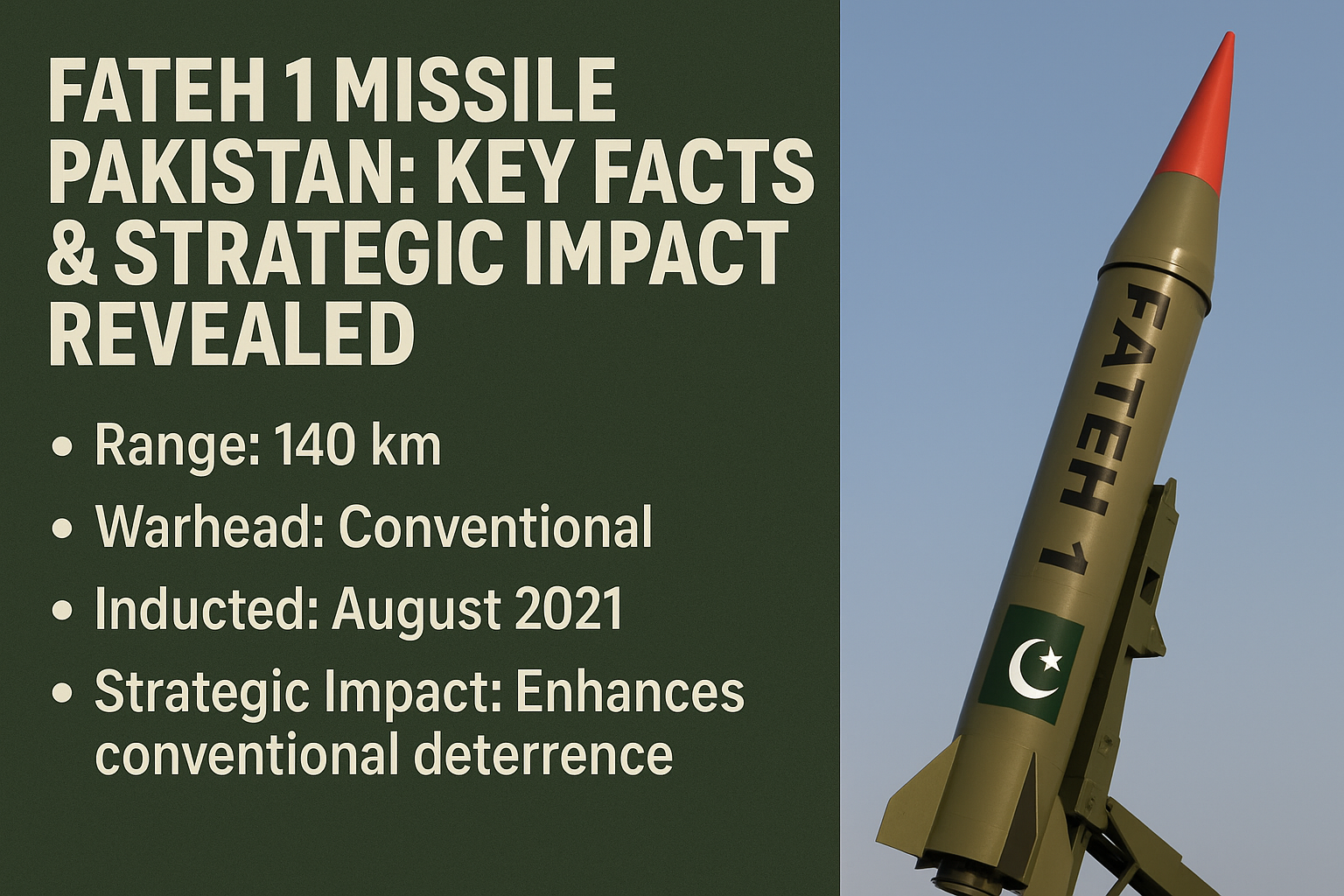
Fateh 1 Missile Pakistan: Key Facts & Strategic Impact Revealed
The Fateh 1 missile Pakistan, also known as Fatah-1, represents a significant milestone in Pakistan’s pursuit of advanced, indigenous defense capabilities. As a guided multiple-launch rocket system (GMLRS), the Fateh 1 missile Pakistan enhances the country’s precision-strike arsenal, designed to deliver conventional warheads with high accuracy over significant distances. Introduced in 2021, this missile system underscores Pakistan’s strategic focus on countering regional threats, particularly in the context of tensions with India. This detailed article explores the development, technical specifications, strategic significance, and recent developments of the Fateh 1 missile Pakistan, providing a thorough understanding of its role in modern warfare.
Introduction to the Fateh 1 Missile Pakistan
The Fateh 1 missile Pakistan is a surface-to-surface guided rocket system developed indigenously by Pakistan’s defense industry. Officially inducted into the Pakistan Army in 2021, the Fateh 1 missile Pakistan is designed to engage targets with precision deep within enemy territory, offering a cost-effective and versatile solution for conventional warfare. Its development reflects Pakistan’s broader strategy to modernize its missile arsenal, reduce reliance on foreign technology, and enhance its deterrence capabilities. The Fateh 1 missile Pakistan is the cornerstone of the Fatah series, which includes advanced variants like Fatah-2, Fatah-3, and Fatah-4, each with progressively longer ranges and enhanced capabilities.
Development History of the Fateh 1 Missile Pakistan
The journey of the Fateh 1 missile Pakistan began with a 2017 initiative by Pakistan’s Ministry of Defence Production (MoDP) to develop an “extended range” multiple-launch rocket system (MLRS). This program aimed to create a domestically produced missile capable of delivering precise strikes, building on the capabilities of earlier systems like the Chinese-origin A-100 MLRS, which had a 100 km range. The Fateh 1 missile Pakistan was first successfully tested on January 7, 2021, with the Inter-Services Public Relations (ISPR) announcing its ability to deliver a conventional warhead over 140 km. A second test on August 24, 2021, validated its operational readiness, paving the way for its induction into the Pakistan Army. These tests highlighted the Fateh 1 missile Pakistan as a significant step forward in Pakistan’s missile technology, showcasing its commitment to self-reliance.
Technical Specifications of the Fateh 1 Missile Pakistan
Understanding the technical details of the Fateh 1 missile Pakistan is crucial to appreciating its capabilities. Based on available data, the Fateh 1 missile Pakistan has the following specifications:
-
Range: 140 km, allowing for deep-strike missions into enemy territory.
-
Diameter: Likely 300 mm, inferred from comparisons with similar MLRS systems.
-
Launcher: 8-cell configuration mounted on a mobile 8×8 truck, ensuring rapid deployment and flexibility.
-
Guidance System: Inertial navigation system (INS) with GPS augmentation, providing a circular error probable (CEP) of approximately 30-50 meters.
-
Warhead: Conventional, designed for precision strikes against military targets such as bases, command posts, and fortified positions.
-
Induction Year: 2021, marking its operational integration into Pakistan’s artillery divisions.
The Fateh 1 missile Pakistan is mounted on a mobile launcher, enabling “shoot-and-scoot” tactics, where the system can fire and relocate quickly to avoid counterattacks. Its advanced navigation system ensures high accuracy, making it a formidable tool for precision engagements. The Fateh 1 missile Pakistan is distinct from unguided rocket systems, offering a level of precision that enhances its tactical utility.
Strategic Role of the Fateh 1 Missile Pakistan
The Fateh 1 missile Pakistan plays a pivotal role in Pakistan’s conventional deterrence strategy, particularly in the context of regional security dynamics with India. Its 140 km range allows the Pakistan Army to target key military infrastructure, such as airbases, command centers, and logistics hubs, without exposing ground forces to direct combat. The Fateh 1 missile Pakistan is designed to counter India’s advancing military doctrines, including the Cold Start Doctrine, which envisions rapid, limited incursions into Pakistani territory. By providing a stand-off precision-strike capability, the Fateh 1 missile Pakistan enhances Pakistan’s ability to disrupt such operations, ensuring a robust defense posture.
The missile’s mobility and rapid deployment capabilities draw inspiration from systems like the U.S. M142 HIMARS, emphasizing flexibility and survivability. Unlike short-range ballistic missiles (SRBMs), which are costlier and require more complex logistics, the Fateh 1 missile Pakistan offers a cost-effective alternative for precision strikes, blending seamlessly with Pakistan’s existing MLRS fleet. Its role in conventional warfare was emphasized by the ISPR, which noted that the Fateh 1 missile Pakistan provides “the capability of precision target engagement deep in enemy territory.”
The Fatah Missile Series: Evolution Beyond the Fateh 1 Missile Pakistan
The Fateh 1 missile Pakistan is the foundation of the Fatah series, a family of guided rockets designed to meet Pakistan’s evolving defense needs. Subsequent variants have expanded the series’ capabilities:
-
Fatah-2: Inducted in 2024 with a 400 km range, featuring a two-cell launcher and a possible 400 mm diameter. It includes a supersonic glide vehicle and maneuvering warhead, enhancing its ability to evade missile defenses.
-
Fatah-3: Under development, expected to have a 450 km range, likely based on Fatah-2 technology.
-
Fatah-4: Also in development, projected to reach 700 km, potentially with a larger 600 mm diameter and the possibility of exceeding 1,000 km in future iterations.
The progression from the Fateh 1 missile Pakistan to these advanced variants demonstrates Pakistan’s ambition to develop a versatile, long-range missile family. Each variant builds on the Fateh 1 missile Pakistan’s foundation, incorporating improvements in range, accuracy, and evasion capabilities to address emerging threats.
Recent Developments Involving the Fateh 1 Missile Pakistan
Recent developments have underscored the Fateh 1 missile Pakistan’s continued relevance in Pakistan’s defense strategy. On May 5, 2025, Pakistan conducted a successful training launch of a Fatah series missile, identified as the Fateh 1 missile Pakistan, with a reported range of 120 km, as part of the “Ex Indus” exercise. The ISPR stated that the launch aimed to ensure troop readiness and validate technical parameters, including the missile’s advanced navigation system and enhanced accuracy. This test occurred amid heightened tensions with India following the April 22, 2025, Pahalgam attack in Jammu and Kashmir, which killed 26 people and escalated regional hostilities. The Fateh 1 missile Pakistan’s deployment in this context highlights its role in signaling Pakistan’s military preparedness.
Posts on X from May 10, 2025, claimed that Pakistan used the Fateh 1 missile Pakistan in strikes on Indian airbases, including Jammu, Pathankot, Srinagar, Udhampur, and others, citing a New York Times report. These claims, attributed to Pakistani security officials, described the Fateh 1 missile Pakistan as a short-range guided missile designed for rapid, high-impact tactical strikes. However, these reports remain unverified and should be treated with caution, as they may reflect heightened rhetoric rather than confirmed actions. Indian sources on X countered that Indian air defenses intercepted all projectiles, indicating no significant damage. The lack of corroborating evidence from official channels suggests these claims are inconclusive.
Comparative Analysis: Fateh 1 Missile Pakistan vs. Global Systems
The Fateh 1 missile Pakistan can be compared to other GMLRS systems to understand its place in global military technology. Unlike the U.S. HIMARS, which has a 300 km range with certain munitions and a modular container system, the Fateh 1 missile Pakistan uses an 8-cell launcher tailored for its 140 km rockets. Its range surpasses India’s Pinaka MLRS, which offers 75-95 km with guided rockets, giving Pakistan a regional advantage in precision rocket artillery. While the Fateh 1 missile Pakistan may not match the range of advanced systems like Russia’s Tornado-S or China’s Weishi series, its indigenous design and cost-effectiveness make it a practical choice for Pakistan’s needs. The Fateh 1 missile Pakistan’s development, possibly with Chinese technical assistance, reflects a balance between innovation and affordability.
Challenges and Limitations of the Fateh 1 Missile Pakistan
Despite its strengths, the Fateh 1 missile Pakistan faces certain challenges:
-
Range Limitation: At 140 km, its range is modest compared to modern GMLRS systems, which often exceed 200 km. This is addressed in later Fatah variants but limits the Fateh 1 missile Pakistan’s strategic reach.
-
Countermeasures: Advanced air defense systems, such as India’s S-400, could potentially intercept the Fateh 1 missile Pakistan, though its low trajectory and mobility reduce this risk.
-
Dependence on Infrastructure: The missile’s effectiveness relies on robust intelligence, surveillance, and reconnaissance (ISR) to identify targets, which may strain Pakistan’s resources.
These challenges highlight the need for continued development, as seen in the Fatah series’ progression beyond the Fateh 1 missile Pakistan.
Future Prospects for the Fateh 1 Missile Pakistan
The Fateh 1 missile Pakistan remains a critical asset as Pakistan advances its missile technology. The ongoing development of Fatah-3 and Fatah-4, with ranges of 450 km and 700 km, respectively, suggests that the Fateh 1 missile Pakistan will be complemented by more capable systems. Potential upgrades, such as laser-guidance kits for integration with unmanned aerial vehicles (UAVs), could enhance the Fateh 1 missile Pakistan’s precision, drawing inspiration from systems like Turkey’s TRLG-230. Pakistan’s focus on indigenous production, as evidenced by Global Industrial and Defence Solutions (GIDS), ensures that the Fateh 1 missile Pakistan and its successors will remain cost-effective and adaptable.
Conclusion: The Enduring Relevance of the Fateh 1 Missile Pakistan
The Fateh 1 missile Pakistan marks a pivotal achievement in Pakistan’s defense modernization, offering a precision-strike capability that strengthens its conventional deterrence. With a 140 km range, advanced navigation, and mobile launcher, the Fateh 1 missile Pakistan provides a versatile and cost-effective solution for engaging enemy targets. Recent tests, such as the May 2025 launch, demonstrate its ongoing operational relevance, while the broader Fatah series signals Pakistan’s ambition to compete in regional missile technology. Despite unverified claims of its use in 2025, the Fateh 1 missile Pakistan remains a cornerstone of Pakistan’s artillery divisions, ensuring a robust defense posture in a volatile geopolitical landscape. As Pakistan continues to innovate, the Fateh 1 missile Pakistan will likely serve as a foundation for future advancements, solidifying its strategic importance.
Have questions about the Fateh 1 missile Pakistan or its role in regional security? Share your thoughts in the comments or contact us for more insights!



